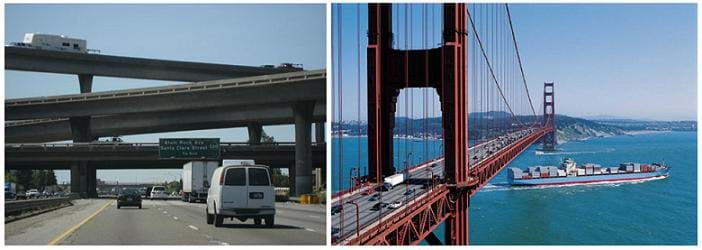
Summary
Through a five-lesson series that includes numerous hands-on activities, students are introduced to the importance and pervasiveness of bridges for connecting people to resources, places and other people, with references to many historical and current-day examples. In learning about bridge types—arch, beam, truss and suspension—students explore the effect of tensile and compressive forces. Students investigate the calculations that go into designing bridges; they learn about loads and cross-sectional areas by designing and testing the strength of model piers. Geology and soils are explored as they discover the importance of foundations, bearing pressure and settlement considerations in the creation of dependable bridges and structures. Students learn about brittle and ductile material properties. Students also learn about the many cost factors that comprise the economic considerations of bridge building. Bridges are unique challenges that take advantage of the creative nature of engineering.Engineering Connection
Engineers are involved in many aspects of weather forecasting and weather-appropriate design. They analyze information about weather when designing instruments such as barometers, thermometers and anemometers—technologies that are essential for accurate weather predictions so that we can make informed decisions about how we interact with our world. Also, computer science engineers develop software to integrate these complex weather information technologies for meteorologists to use to make such predictions and inform the public. Engineers develop websites (and software) to present predicted and historical weather information in the most informative and pleasing way for people to understand. Civil engineers utilize weather data when designing bridges, houses and other structures, to ensure that those designs are appropriate for the climate of their locations. Environmental engineers analyze weather measurements to determine the placement and effectiveness of renewable energy technologies, such as wind farms and solar arrays. Engineers also serve an important role in designing products that enable people to more comfortably adjust to the weather (for example, waterproof jackets, heated driveways and sunscreen, and many other weather-resistant goods).
Unit Overview
Overview of topics, by lesson: 1) bridge types, tension and compression forces; 2) design, loads, piers/columns and girders/beams; 3) geology, foundations, bearing pressure and settlement; 4) strength of materials; and 5) economics, estimates, costs.
Educational Standards
Each TeachEngineering lesson or activity is correlated to one or more K-12 science,
technology, engineering or math (STEM) educational standards.
All 100,000+ K-12 STEM standards covered in TeachEngineering are collected, maintained and packaged by the Achievement Standards Network (ASN),
a project of D2L (www.achievementstandards.org).
In the ASN, standards are hierarchically structured: first by source; e.g., by state; within source by type; e.g., science or mathematics;
within type by subtype, then by grade, etc.
Each TeachEngineering lesson or activity is correlated to one or more K-12 science, technology, engineering or math (STEM) educational standards.
All 100,000+ K-12 STEM standards covered in TeachEngineering are collected, maintained and packaged by the Achievement Standards Network (ASN), a project of D2L (www.achievementstandards.org).
In the ASN, standards are hierarchically structured: first by source; e.g., by state; within source by type; e.g., science or mathematics; within type by subtype, then by grade, etc.
See individual lessons and activities for standards alignment.
Subscribe
Get the inside scoop on all things TeachEngineering such as new site features, curriculum updates, video releases, and more by signing up for our newsletter!Unit Schedule
- Day 1: Bridging the Gaps lesson
- Day 2: Bridge Types: Tensile & Compressive Forces activity
- Day 3: Straw Bridges activity
- Day 4: Designing Bridges lesson
- Day 5: Load It Up! activity
- Day 6: A Good Foundation lesson
- Day 7: Shallow & Deep Foundations activity
- Day 8: Strength of Materials lesson
- Day 9: Breaking the Mold activity
- Day 10: Show Me the Money lesson
- Day 11: Cost Comparisons activity
More Curriculum Like This

Students explore the effects of regional geology on bridge foundation, including the variety of soil conditions found beneath foundations. They learn about shallow and deep foundations, as well as the concepts of bearing pressure and settlement.

Students learn about the types of possible loads, how to calculate ultimate load combinations, and investigate the different sizes for the beams (girders) and columns (piers) of simple bridge design. Additionally, they learn the steps that engineers use to design bridges.
Other Related Information
For an amazing bridge image and a story about an incredible US bridge project, see the July 4, 2009 Daily Mail story, "The Wider View: Taking Shape, the New Bridge at the Hoover Dam," on the 2010 Hoover Dam bypass bridge (called the "Colorado River Bridge") at http://www.dailymail.co.uk/news/article-1197544/THE-WIDER-VIEW-Taking-shape-new-bridge-Hoover-Dam.html
For an interesting time lapse of construction photos of the 10-year creation process of the 2010 Hoover Dam bypass bridge, see https://www.youtube.com/watch?v=fu4_gY5TFOY
Copyright
© 2006 by Regents of the University of ColoradoContributors
See individual lessons and activities.Supporting Program
Integrated Teaching and Learning Program, College of Engineering, University of Colorado BoulderAcknowledgements
This digital library content was developed by the Integrated Teaching and Learning Program in the College of Engineering and Applied Science under National Science Foundation grant no. 0338326. However, these contents do not necessarily represent the policies of the National Science Foundation and you should not assume endorsement by the federal government.
Last modified: April 26, 2017





User Comments & Tips